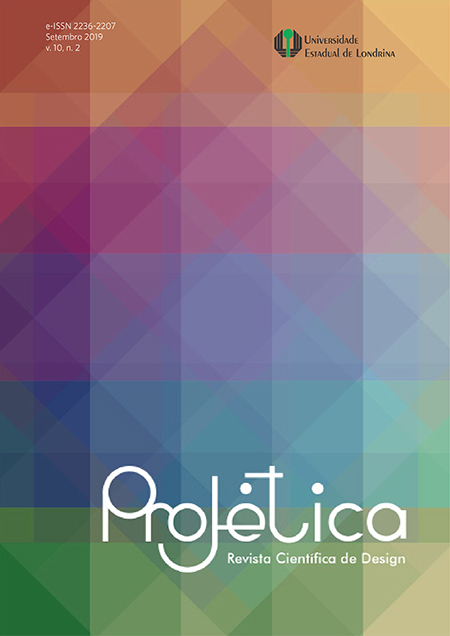Atributos estéticos e sustentabilidade: estudo de caso com mochilas de marcas gaúchas
DOI:
https://doi.org/10.5433/2236-2207.2019v10n2p169Palavras-chave:
Design, Sustentabilidade, Estética, Atributos visuaisResumo
Entendendo a crescente relevância da questão estética no desenvolvimento de produtos sustentáveis, o estudo objetiva verificar a aplicação de estratégias que contemplem esta abordagem em projetos. Observando dissonâncias e concordâncias entre estudos teóricos e mercado na definição e adoção destas estratégias, analisa atributos estéticos propostos em publicações anteriores aplicando-os a um estudo de caso com marcas de mochilas sustentáveis na cidade de Porto Alegre.Downloads
Referências
BONSIEPE, Gui. Diseño Industrial tecnologia y ecologia. In: BONSIEPE, Gui. Diseño Industrial: artefacto y proyecto. Madrid: Alberto Corazón Editor, 1975. p. 27-31.
CHIM, Irina Sonia; BLEBEA, Ioan. A sustainable approach to product design. Acta Technica Napocensis Series: Applied Mathematics, Mechanics, and Engineering, Napoca, ROM, v. 56, n. 1, p. 63-72, 2013a.
CHIM, Irina Sonia; BLEBEA, Ioan. The aesthetic value: a green atribute of sustainable product design. Acta Technica Napocensis Series: Applied Mathematics, Mechanics, and Engineering, Napoca, ROM, v. 56, n. 2, p. 367–374, 2013b.
GIVEN, Lisa. M. (ed.). The sage encyclopedia of qualitative research methods. Los Angeles, CA: SAGE Publication, 2008. v. 1/2.
HEKKERT, Paul; LEDER, Helmut. Product aesthetics. In: HEKKERT, Paul; SCHIFFERSTEIN, Hendrik N. J. Product experience. Amesterdan, NL: Elsevier, 2008. p. 259-285.
HENNES, Mariana; COUTINHO, Solange G. Letreiros populares do Recife: uma análise dos seus elementos pictóricos. Blucher Design Proceedings, São Paulo, SP, v. 1, n. 2, p. 1–9, May 2014.
MARTIN, Bella; HANINGTON, Bruce. Universal methods of design: 100 ways to research complex problems, develop innovative ideas and design effective solutions. Beverly, MA: Rockport Publishers, 2012.
MCDONAGH, Deana; BRUSEBERG, Anne; HASLAM, Cheryl. Visual product evaluation: exploring users’ emotional relationships with products. Applied Ergonomics, Guildford, IA, v. 33, n. 3, p. 231-240, 2002.
NIINIMÄKI, Kirsi. Green aesthetics in clothing: normative beauty in commodities. Artifact: Journal of Design Practice, Oxford, OX, v. 3, n. 3, p. 1-13, 2014.
PAPANEK, Victor. Diseñar para el mundo real: ecologia humana y cambio social. Madrid: H. Blume, 1977.
PETERSEN, Moritz; BROCKHAUS, Sebastian. Dancing in the dark: challenges for product developers to improve and communicate product sustainability. Journal of Cleaner Production, Amsterdam, NL, v. 161, p. 345-354, 2017.
SHEDROFF, Nathan. Design is the problem: the future of design must be sustainable. New York: Louis Rosenfeld, 2009.
TONE, Herbert; SIDEL, Joel L.; BLOOMQUIST, Jean. Quantitative descriptive analysis. In: GACULA JUNIOR, Maximo C. (ed.). Descriptive sensory analysis in practice. Scottsdale, AZ: Gacula Associates, 2008. Chap. 1.6.
STONE, Herbert; SIDEL, Joel; OLIVER, S.; WOOLSEY, Annette; SINGLETON, Richard C. Sensory evaluation by qualitative descriptive analysis. Food Technology, Chicago, ILL, v. 28, n. 11, p. 24–34, 1974.
TWYMAN, Michael. A schema for the study of graphic language (tutorial paper). In: KOLERS, Paul; WROLSTAD, Merald; BOUMA Herman (ed.). Processing of visible language. Boston, MA: Springer, 1979. p. 117-150.
WALKER, Stuart. The environment, product aesthetics and surface. Design Issues, Chicago, ILL, v. 11, n. 3, p. 15-27, 1995.
WHITELEY, Nigel. Design for society. London: Reaktion Books, 1993.
ZAFARMAND, Seyed Javad; SUGIYAMA, Kazuo; WATANABE, Makoto. Aesthetic and sustainability: the aesthetic attributes promoting product sustainability. The Journal of Sustainable Product Design, Basel, SWZ, v. 3, n. 3/4, p. 173–186, 2003.
Downloads
Publicado
Como Citar
Edição
Seção
Licença
Projética está licenciada sob a Creative Commons Attribution CC-BY 4.0 International. Os autores detém os direitos autorais e concedem à revista o direito de exclusividade de primeira publicação.
Os autores dos trabalhos aprovados autorizam Projética a, após a publicação, ceder seu conteúdo para reprodução em indexadores de conteúdo, bibliotecas virtuais e similares.
Os autores assumem que os textos submetidos à publicação são de sua criação original, responsabilizando-se inteiramente por seu conteúdo em caso de eventual impugnação por parte de terceiros. As opiniões emitidas pelos autores dos artigos são de sua exclusiva responsabilidade.
A revista se reserva o direito de efetuar, nos originais, alterações de ordem normativa, ortográfica e gramatical, com vistas a manter o padrão culto da língua e a credibilidade do veículo. Respeitará, no entanto, o estilo de escrever dos autores. Alterações, correções ou sugestões de ordem conceitual serão encaminhadas aos autores, quando necessário. Nesses casos, os artigos, depois de adequados, deverão ser submetidos a nova apreciação. As provas finais não serão encaminhadas aos autores.











